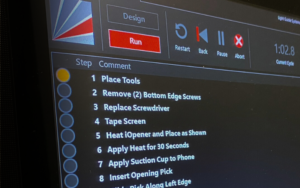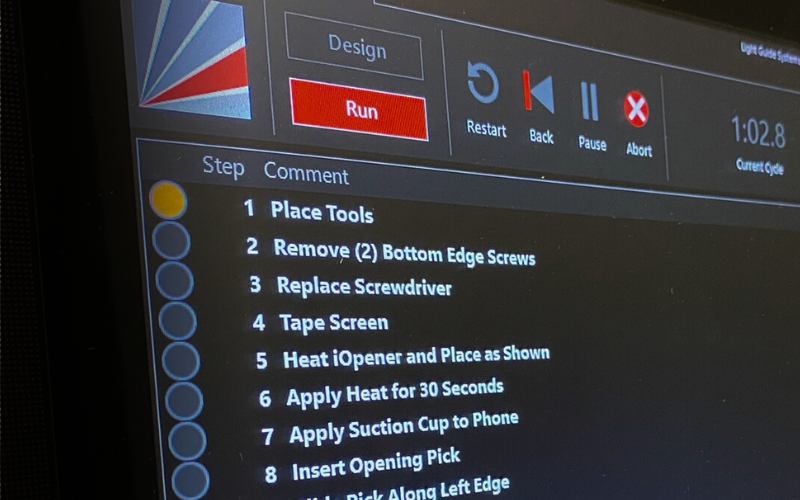
In manual assemblies, many of the errors that occur are assumed to be “human errors.” Often, taking a deeper look at the systems and procedures in place can reveal the real issue; inefficient and impractical work instructions.
Benefits of Work Instructions
Work instructions are documents that explain how to complete every step of a standard operating procedure (SOP).
Different from a process document or SOP, work instructions go into more detail about how a worker needs to carry out an operation. Katrina Dessavre from Beekeeper.io explains it best, “Processes describe what objectives and specifications need to be done. SOP’s describe how a process should be carried out in certain situations. Work instructions describe how each of the steps in an SOP should be carried out.”
Work instructions standardize processes, so there is a system-based, quantified approach to tracking operations. There are a few specific benefits they provide:
- Make knowledge more widely available and easier to comprehend.
- Encourage more analysis of processes and finding ways to refine them over time.
- Increase the traceability of the whole process, making it possible to pinpoint issues that weren’t identifiable before.
- Standardize training programs and make them easier to scale.
By having work instructions, companies are investing in their own value. Dessavre reflects this, saying that “By focusing on a more systems-based approach, companies can give employees tools to make better decisions and fewer mistakes.”
The detailed nature of work instructions makes it easier to communicate the exact wants and needs of an operation. Implementing them makes it easier to understand the procedure on multiple organizational levels and fast-tracks operative success.
How to Write Practical Work Instructions
While writing work instructions may seem straightforward, people often make them inefficient or impractical by not strategizing before writing. Here are 6 tips to make your work instructions practical.
Understand Your Audience
Before writing anything, understand who is going to be using these procedures. No matter how much time and energy someone puts into writing work instructions, they won’t work if they aren’t accepted by the audience; in this case the workers.
Also, keep in mind that the workers are the best resource for understanding a process and making it more efficient. Including workers in the writing process will help workers engage with the new work instructions when they feel that their opinions are supported and included.
Keep It Simple
Try to keep track of how many actions are in one step. Only one action should take place in each step. Yes, it can make instructions longer, but it guarantees that more attention is paid to each action, reducing the risk of defects.
Make sure that the instructions are comprehensive by writing multiple iterations. Try to complete the procedure yourself or watch someone else do it to match the instructions to the actions. Then, simplify as needed, keeping it in as few words as possible.
Make It Visual
Visual instructions are known for being more effective than text. T-sciences.com found research that “we respond to and process visual data better than any other type of data. In fact, the human brain processes images 60,000 times faster than text, and 90 percent of information transmitted to the brain is visual.”
Including graphics, videos, and animations speeds up operations and reduces cognitive workload. With augmented reality technology, projected graphics light the way so a worker is literally pointed in the right direction using arrows.
Consistently Update
The most important factor of keeping work instructions is making sure they are updated consistently. Digital work instructions make this easy, implementing new changes on an enterprise-level in seconds.
Digitally Transform
Transferring your procedures to digital programs considerably cuts down on the time and effort needed to create and update them. It’s less like writing and more like a plug-and-play system.
More data is accessible through a digital platform. Whereas paper work instructions can only quantify information from the final output, digital captures information from every step of the process.
On top of that, digital platforms centralize data. It is collected from any point in the factory and shared anywhere—in the factory or on an enterprise level. Data and other information can also be secured. Then, only specific employees can access information as needed.
For workers, digital instructions simplify processes even further by making them easier to comprehend. Research by Torres, Nadeau, and Landau shows that “technology can also decrease workers’ cognitive load and reduce the dynamic complexity of assembly. With the development of human support technologies within the framework of the Operator 4.0, the integration of several technologies into assembly guidance systems could benefit workers and system performance.”
Use Subroutines
Digital work instructions also have the added benefit of subroutines. If an action recurs multiple times throughout a process, write it one time in the program and use the subroutine to refer back to the information. Then, you don’t have to write it every time in every place it occurs. And when there is a change to that routine, you only have to edit it in one place and it will apply that change throughout.
Ultimately, work instructions are going to evolve your processes. Using these tips will standardize your factory and give an advantage to current and future operations.
Looking to upgrade your work instructions? Contact our LightGuide engineers to get specific answers about updating your procedures.


